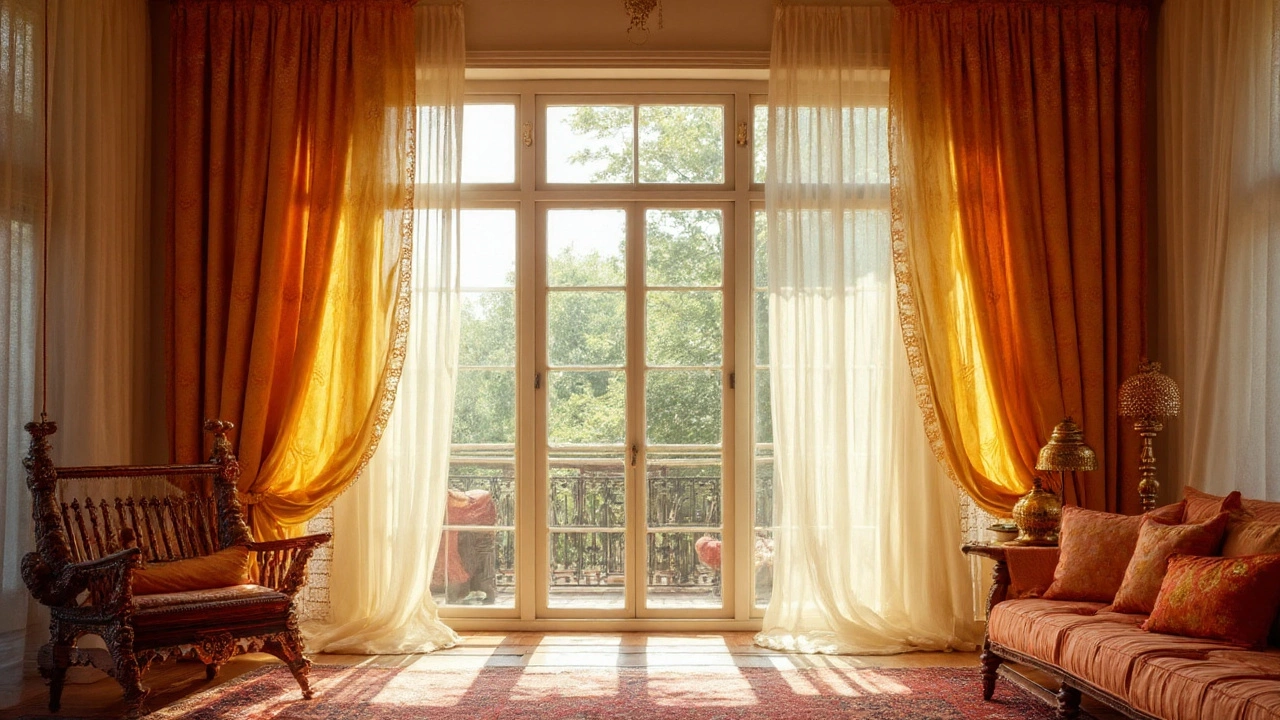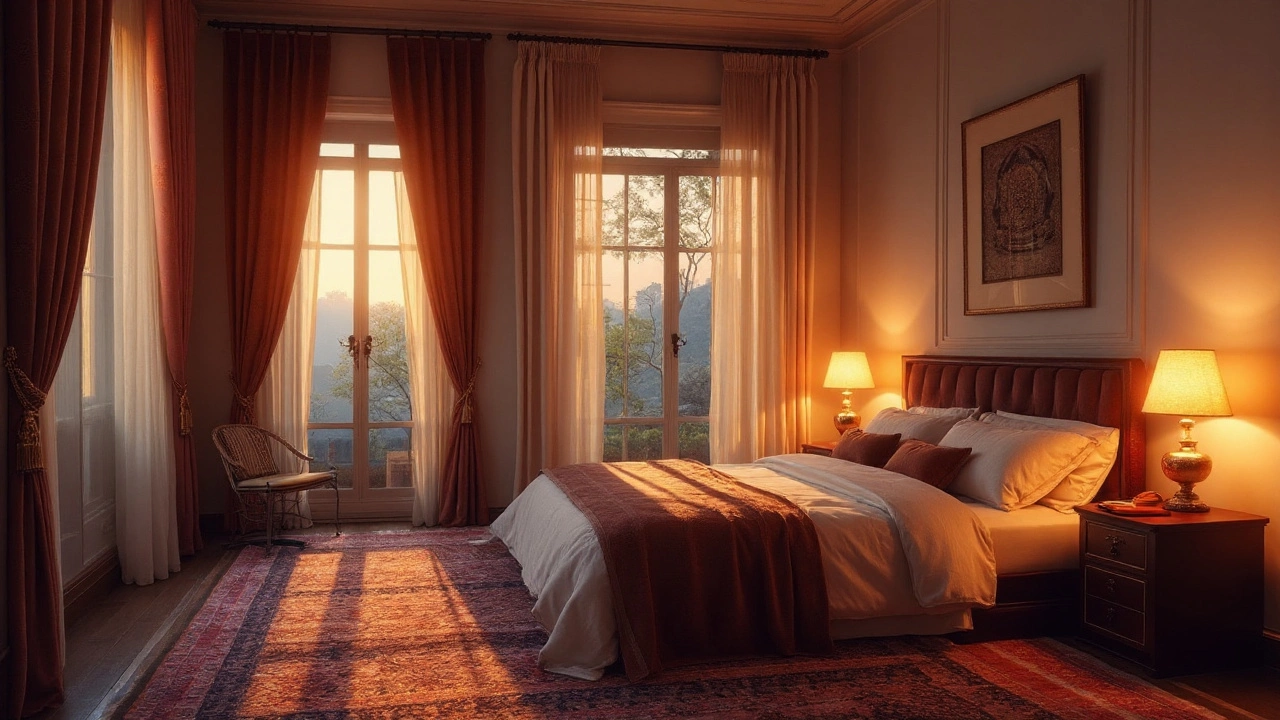Drapes vs Curtains: Key Differences, Benefits, and How to Choose

Is your living room feeling a bit off, but you can’t put your finger on why? Or maybe your bedroom is flooded with sunlight long before your alarm goes off? Here’s a fun fact: your choice between drapes and curtains can make or break the entire mood of a space. Yet, loads of folks still mix them up. Shops toss both words around as if they mean the same thing, but if you know the difference, you’ve got a secret weapon for killer style and perfect light control.
What Sets Drapes Apart from Curtains?
On the surface, drapes and curtains both hang stylishly from rods at your window, and at first glance, they do look similar. But dig a little deeper, they’re two totally different breeds. Curtains are usually made of lighter fabrics. Cotton, linen, or synthetics—these let sunlight filter through, giving a room that breezy, open vibe. It makes them perfect for kitchens or living rooms where you want to enjoy natural light but still keep out nosey neighbours.
Now, drapes? They’re the heavyweights of the window world. Think silk, velvet, or thick polyester blends, often lined for extra heft. Drapes reach either to the floor or pool a bit dramatically, just to show off. You’ll usually find them in formal spaces—maybe your gran’s sitting room or in posh hotels. Their main job isn’t just to look fancy; they block out light, hide what’s happening inside, and insulate against cold or heat. Loads of theatre curtains are basically drapes, just enormous ones!
UK interior brands like Laura Ashley and John Lewis usually market curtains as everyday, versatile coverings; drapes, meanwhile, are styled for drama, privacy, and complete darkness if you go for the blackout kind. An insider tip: if you’ve got big bay windows or high ceilings, drapes bring a touch of grandeur that curtains can’t touch.
Here’s a quick comparison that spells out the differences.
| Feature | Curtains | Drapes |
|---|---|---|
| Fabric | Light/Medium | Heavy/Lined |
| Length | Mostly to windowsill or below | Floor length, sometimes pooling |
| Use | Everyday, informal | Formal, dramatic |
| Light Control | Diffuses / filters | Blocks (especially blackout drapes) |
| Insulation | Minimal | Excellent |
Loads of people try to use curtains where drapes should go and wonder why their bedrooms are still too bright. Or they throw drapes in a playroom and end up with a cave. Think about what you want: Soft sunshine? Go for curtains. Total darkness for movie marathons or sleep? Drapes have your back.

Why Fabric, Lining, and Hardware Matter
Picking between drapes and curtains isn’t just about heavy or light material—fabric, lining, and even the rods make a massive difference. Let’s say you love the look of velvet drapes. If they aren’t lined? You’ll still get some light bleeding through and not as much thermal insulation. So, lined fabrics are crucial if you want real blackout or if you live in a draughty old house. There’s actually evidence showing that lined, floor-to-ceiling drapes can cut heat loss through windows by 15–25% in colder climates (source: Energy Saving Trust UK)—that’s nothing to sneeze at when you think about heating bills.
Curtains hang best on basic rods, rings, or even those cheeky eyelets for a wavy ripple. Drapes are heavy, so you want sturdy hardware—thick rods, serious wall brackets, sometimes even special tracks if the fabric is extra dense. Ever seen a curtain rod sagging in the middle? That’s what happens if you hang drapes on cheap fittings.
The right lining turns your drapes or curtains from just decorative into proper insulation and blackout solutions. Blackout linings can block up to 99% of external light—so if you’re working shifts or want your cave extra dark, add that layer. There’s also thermal lining, which traps heat and throws back out the cold, perfect for those single-glazed windows Manchester’s terraced houses love so much. Want to get creative? Mix and match: hang sheer curtains closest to the window and heavy drapes over the top. This “double dress” approach lets you tweak light, privacy, and style day and night.
One last “dad tip”: measure properly. When it comes to buying drapes, remember they look better a bit too long than short. Measuring to just skim, kiss, or even pool on the floor adds lots more style points than stopping at the sill. Bonus points for rods that extend past the window edges—this gives a fuller look and makes your window look bigger (no brainer, really).

When to Use Drapes and When Curtains Make More Sense
Let’s get real: not every room needs big, fancy drapes. Some spaces—kitchen windows, bathrooms, kids’ bedrooms—are often better off with light, easy-to-wash curtains. You don’t want to drag heavy velvet through cake crumbs and splashing bathwater, trust me.
Drapes shine in places where you want privacy, quiet, or cosiness—think bedrooms, home cinemas, or even the home office if you want to cut out glare. Ever tried sleeping through a northern summer sunrise in Manchester with just cheap curtains? You wake up with the sparrows. Swap in blackout drapes and you could sleep till lunchtime. If streetlights keep you up at night, blackout lining is a game changer. And here’s the cool bit: according to a 2023 survey by the British Blind and Shutter Association, 67% of people in the UK who switched to blackout drapes said their sleep quality improved within a week.
But curtains win the convenience battle hands down—they’re way easier to wash, take down, and swap out when you’re sick of the print (which happens surprisingly often, let’s be honest). If you like to refresh your decor seasonally, curtains are a friendly pick. Think bright floral for spring, cosy tartans for autumn. You’re not committed for years. Small kids or pets? Stick with curtains you can chuck in the washing machine after muddy paw prints or fingerprints from an art project gone wild.
If you want noise reduction, thick drapes with acoustic lining are surprisingly effective. Manchester city traffic, early morning neighbours, all hushed. Got drafty sash windows? Heavy drapes feel like insulating a wall with style. Or you can layer: sheers by day for light and view, drapes drawn for darkness and warmth after sundown.
Still unsure what’s best? Ask yourself: Do I need privacy or just want prettiness? Is heat escaping through my windows? Am I fed up with waking up with the birds? For flexibility, nothing beats a layered set-up. Sheer curtains inside, blackout drapes over the top. And don’t skimp on good hardware—nothing looks sadder than luxe drapes on a flimsy rod. If you love a dramatic statement, don’t be shy—go floor to ceiling with your drapes, pile them high and full at the top, and your living room suddenly feels straight out of a period drama.
"Nothing transforms a room quicker or cheaper than the right window coverings—it’s the unsung hero of home decorating," says Ben Kendrick, interior designer and contributing editor to House Beautiful UK.
Still on the fence? Walk into any room and try picturing it with each style. Your gut usually knows best. And if you want to experiment without commitment, brands like IKEA and Dunelm make affordable versions of both so you can try before you splash out on the bespoke stuff. Whatever you pick, take your time—your windows, walls, and even your sleep schedule will thank you.